Institute of Oceanology, Chinese Academy of Sciences
Article Information
- SHOU Lu(寿鹿), LIAO Yibo(廖一波), TANG Yanbin(汤雁滨), CHEN Jianfang(陈建芳), JIANG Zhibing(江志兵), GAO Aigen(高爱根), CHEN Quanzhen(陈全震)
- Seasonal distribution of macrobenthos and its relationship with environmental factors in Yellow Sea and East China Sea
- Chinese Journal of Oceanology and Limnology, 36(3): 772-782
- http://dx.doi.org/10.1007/s00343-018-6271-1
Article History
- Received Oct. 14, 2016
- accepted in principle Mar. 10, 2017
- accepted for publication Mar. 31, 2017
2 Key Laboratory of Applied Marine Biotechnology, Ministry of Education, Marine College of Ningbo University, Ningbo 315211, China
Macrobenthos are consumers and transporters in material circulation and energy flow within marine ecosystems, and are important in both pelagic-benthic coupling and biogeochemical cycles (Conlan et al., 2008). The benthos can alter the chemical composition of sediments and affect their stability by bioturbation (Norkko et al., 2001), consume oxygen and release particulate matter and nutrients to the water column through feeding, burrow construction and other activities (Kamp and Witte, 2005), obtain nutrients by consuming plankton (Snelgrove et al., 2001), and be preyed on by demersal fish (Crawford et al., 2007).
As one of the world's most important marginal seas, the Yellow and the East China Seas have attracted widespread attention from scientists (Li, 2003; Liu and Li, 2003; Lin et al., 2004; Peng et al., 2014). Owing to high costs, marine ecological surveys over the past few decades have been limited on both spatial and time scales. For example, most studies have focused on macrobenthos in estuaries (Li et al., 2007a, 2016a, b; Liu et al., 2008, 2014), nearshore (Hu et al., 2000, 2006) or bays (Li et al., 2001, 2005a; Liao et al., 2011; Wang et al., 2011; You et al., 2011), with only one or two cruises (Liu and Li, 2003; Lin et al., 2004; Peng et al., 2014) in the Yellow Sea, East China Sea or adjacent waters. There are clear spatiotemporal variations in the environmental characteristics of the Yellow and East China Sea regions, which may lead to incomplete understanding of changes in macrobenthos distribution and corresponding influences.
With the opportunity offered by the National Program on Key Basic Research and Development program entitled "Evolution, mechanism and the prediction of the future trends of the marine ecological environment in the continental shelf of China, " we conducted a four-season survey and sampled macrobenthos of the Yellow and East China Seas during 2011 to 2012. Our study was aimed at illustrating temporal and spatial distributions of macrobenthic communities in the studied areas, to understand the relationship between benthic communities and environmental factors and provide a reference for understanding the evolution of marine ecosystems and environmental effects.
2 MATERIAL AND METHOD 2.1 Study areaThe East China and Yellow Seas adjoin at midlatitudes, forming a western boundary of the Pacific Ocean. Because wide continental shelves and large amounts of terrigenous material received from the Changjiang (Yangtze) River, the East China and Yellow Seas have a highly representative ecosystem, and are thus becoming some of the world's most important marginal seas (Zhai et al., 2014). Rapid development and previous exploitation have changed the seas into the most vulnerable ecosystem in the world. The ecological security of these areas is strongly related to the sustainable development of society and the economy. In recent years, because of rapid economic development, the marine ecology, resources, environment, and other aspects of this area have been damaged to varying degrees by humans, and are under enormous pressure (Anderson et al., 2002; Li et al., 2007b; Jiang et al., 2014). The southern Yellow Sea is mainly influenced by the Yellow Sea Coastal Current, Yellow Sea mixed water, Yellow Sea Cold Water Mass (YSCM), and river plumes from the Han-gang and Huaihe rivers (Peng et al., 2014). The East China Sea, on the other hand, is mainly influenced by Changjiang Diluted Water, Taiwan Warm Current, the Kuroshio, coastal current, YSCM, shelf mixed water and upwelling in the Changjiang River Estuary, and Zhejiang coastal waters (Su and Yuan, 2005).
2.2 Sampling designSamples were taken during a cruise in the Yellow and East China Seas on R/V Dong Fang Hong No. 2 during March 17–April 7, 2011 (Spring), July 6–July 24, 2011 (summer), October 17–November 5, 2011 (autumn), and December 20, 2011–January 11, 2012 (winter). The sampling sites covered most parts of the two seas, with slight adjustments in different seasons (Fig. 1). The survey and monitoring were performed according to "The Specification for Oceanographic Survey" (GB/T 12763-2007) and "The Specification for Marine Monitoring" (GB17378-2007). At each sampling site, a Day grab sampler (0.1 m2) was used to collect sediments twice per site, followed by rinsing with a 0.5-mm mesh sieve. Samples were fixed with 5%–7% neutral buffered formaldehyde in situ, and sample analysis (e.g., species identification, counting and weighing) were performed in the lab. Bottom water temperature, salinity and depth were recorded by a SeaBird 911 CTD (Sea-Bird Electronics, Bellevue, WA, USA). Simultaneously, we measured pH and the concentrations of chlorophyll a, dissolved oxygen (DO), phosphate (PO4-P), dissolved inorganic nitrogen (DIN, including nitrates, nitrites and ammonium salts), and silicate (SiO3-) of the bottom water.
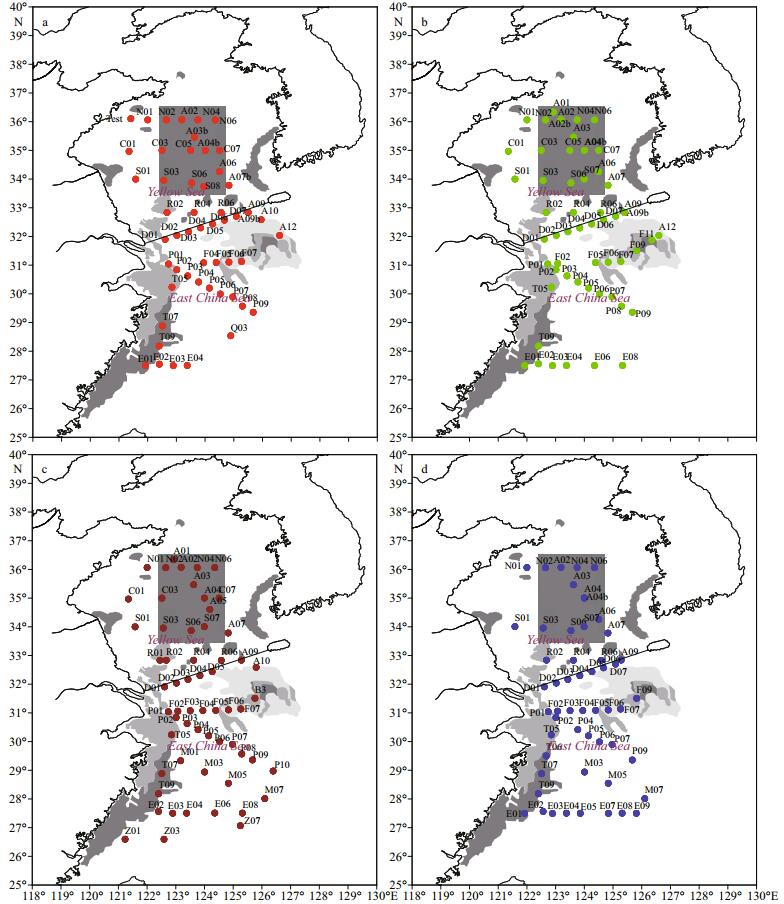
|
| Figure 1 Sampling sites of macrobenthos in Yellow and East China Seas a. spring; b. summer; c. autumn; d. winter. |
A two-factor analysis of variance (ANOVA) was performed using STATISTICA 6.0 on parameters for macrobenthic communities in the Yellow and East China Seas, with season and region as factors. Before statistical analysis, normality and homogeneity of data variance were examined using the KolmogorovSmirnov and Bartlett tests, respectively, and the significance level was set to α=0.05 (Yi, 2002). PRIMER 6.0 software was used to calculate the species number (S), Shannon-Wiener diversity index (H'), and Pielou's evenness index (J) of the macrobenthic communities. Macrobenthic communities in various seasons and regions were compared using two-factor analysis of similarities (ANOSIM), and multi-dimensional scaling (MDS) were used to investigate differences in community structure within PRIMER 6.0. At the same time, the average contribution rate of each macrobenthic species to similarity in the different regions was analyzed by the similarity percentages (SIMPER) method, and the five species with the highest cumulative contribution rates in each region and season were defined as the main characteristic species (Clarke and Gorley, 2006). Canonical correspondence analysis (CCA) was done using Canoco for Windows 4.5 to analyze the relationship between dominant macrobenthic species and environmental parameters, and the significances of all ordination axes of CCA were examined using a Monte Carlo test (Ter Braak and Šmilauer, 2002).
3 RESULT 3.1 Composition of macrobenthic species and dominant species 3.1.1 Species composition and distributionAmong the macrobenthos collected from the Yellow and East China seas, 562 species were identified, including 224 of polychaetes and 151 of mollusks, accounting for ~67% of all macrobenthic species, thus constituting the dominant species in the study area. The macrobenthic species compositions in various regions are shown in Fig. 2. In the southern Yellow Sea, there were 331 macrobenthic species, including 160 of polychaetes and 72 of mollusks (accounting for ~70% of the total number of all species). In the East China Sea, there were 453 macrobenthic species, including 194 of polychaetes and 114 of mollusks (accounting for ~68% of the total number of all species).
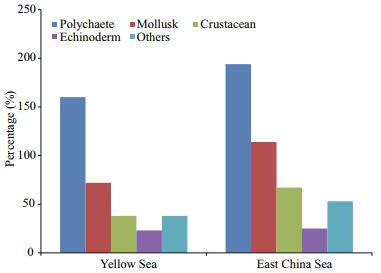
|
| Figure 2 Species composition of macrobenthos in Yellow and East China Seas |
The result from SIMPER analysis showed that the dominant species in the Yellow and East China seas were significantly different, and the community dissimilarity indexes for four seasons were all > 90% (spring: 96.67%; summer: 94.74%; autumn: 93.56%; winter: 92.05%). In all seasons, the dominant species in the Yellow Sea had larger sizes (e.g., bivalves), while those in the East China Sea were smaller (e.g., polychaetes) (Table 1).

|
The parameters for macrobenthic communities in the Yellow and East China Seas are shown in Table 2. The result from two-factor ANOVA showed that the species number, density and diversity index all had significant seasonal variations. In the Yellow Sea, the species number and diversity index in fall and winter were significantly larger than those in spring and summer, respectively, and the density in fall was significantly higher than those in other seasons. In the East China Sea, the species number, density and diversity index in summer and fall were significantly higher than those in winter and spring, respectively. Significant regional differences were evidenced for biomass and density. Except for summer, densities in other seasons and biomass in all seasons in the Yellow Sea were significantly higher than those in the East China Sea.
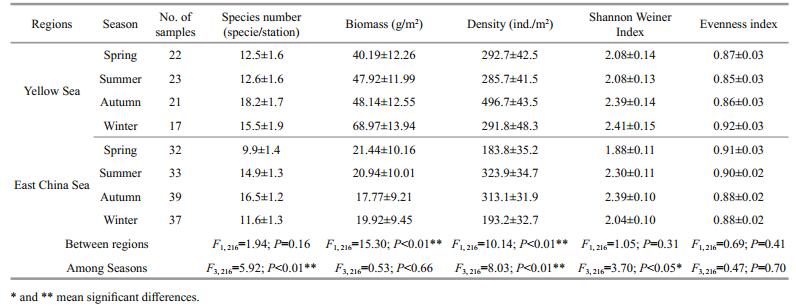
|
The two-factor ANOSIM was performed on the macrobenthic communities, with region (the Yellow Sea and the East China Sea) and season (four seasons) as factors. The macrobenthic communities showed significant seasonal (global test R=0.134, P=0.001) and regional (global test R=0.231, P=0.001) differences, as in MDS analysis (Fig. 3).
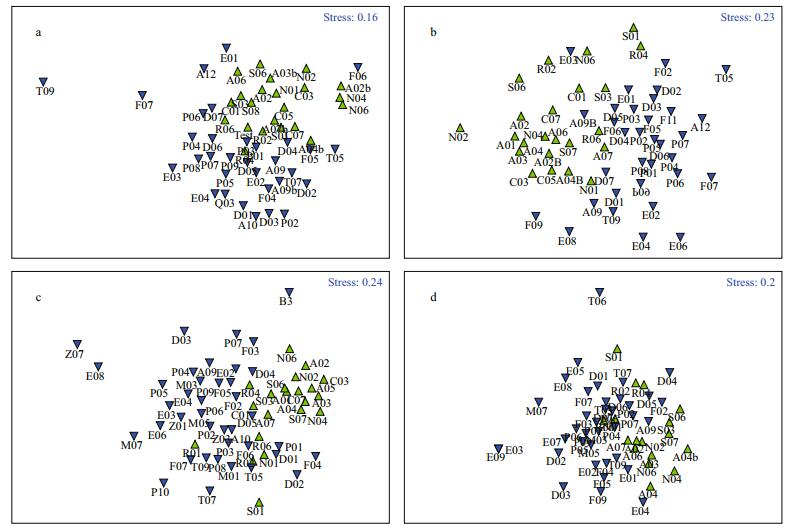
|
| Figure 3 MDS analysis of macrobenthos in Yellow and East China Seas a. spring; b. summer; c. autumn; d. winter; ▲: Yellow Sea; ▼: East China Sea. |
The dominant species and environmental factors were selected for CCA. The Monte Carlo significance test revealed that the first and all ordination axes in the CCA had significant differences (1st axis: F=12.174, P=0.016; all axes: F=3.921, P=0.002). As seen from the CCA ordination diagram (Fig. 4), water depth, temperature, DO and DIN had larger impacts on macrobenthos among the various environmental factors. Among them, temperature was negatively related to the first axis, with a correlation coefficient of -0.897. DO was positively correlated with the first axis, with a correlation coefficient of 0.301 4. Water depth was positively correlated with the second axis, with a correlation coefficient of 0.595 9, and DIN was negatively correlated with the second axis, with a correlation coefficient of -0.380 4. Table 3 shows characteristic values of each ordination axis and the correlation coefficients between the macrobenthic functional groups and environmental factors.
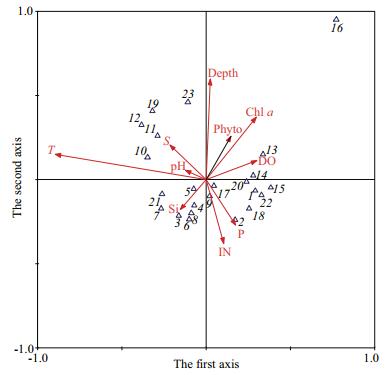
|
| Figure 4 CCA ordination diagrams of macrobenthos and environmental factors in Yellow and East China Seas T: temperature; S: salinity; pH: degree of acidity or alkalinity; DO: dissolved oxygen; IN: inorganic nitrogen; P: phosphorus; Si: silicate; Chl a: Chlorophyll a; Phyto: phytoplankton; 1: Melinna cristata; 2: Terebellides stroemii; 3: Aglaophamus dibranchis; 4: Lumbrineris heteropoda; 5: Lumbrineris cruzensis; 6: Lumbrineris sp.; 7: Dasybranchus caducus; 8: Notomastus latericeus; 9: Ophelina acuminate; 10: Dentalium octangulatum; 11: Cavolinia uncinata; 12: Cavolinia longirostris; 13: Nucula (Leionucula) nipponica; 14: Nucula (Leionucula) tenuis; 15: Thyasira tokunagai; 16: Raetellops pulchella; 17: Ampelisca sp.; 18: Eocuma lata; 19: Callianassa sp. 20: Ophiura sarsii vadicola; 21: Apionsoma trichocephala; 22: Portlandia japonica; 23: Cavolinia tridentate. |
Two-factor community ANOSIM results indicated significant differences in macrobenthic community structure across the two seas (global test R=0.231, P=0.001). In terms of species composition, 562 macrobenthic species were identified from the two seas, and the number of such species in the East China Sea (453) was significantly larger than that of the Yellow Sea (331). The dominant microbenthic species in both seas were polychaetes and mollusks, whose proportions were very similar in the two seas. Liu and Li(2002, 2003) reported that during spring/ fall in the East China Sea and southern Yellow Sea, there were a total of 392 and 272 macrobenthic species in 2002 and 2003, respectively, slightly smaller numbers than in the present research because of differences in survey sites and season. Furthermore, except for a box corer (0.1 m2), an Agassiz trawl was used for qualitative sampling of benthic fauna in Liu and Li(2002, 2003), and the proportions of crustaceans (East China Sea: 30.1%; Yellow Sea: 30.5%) were much larger than those in our survey (East China Sea: 14.8%; Yellow Sea: 11.5%). In Jiang et al. (1985a), 1287 macrobenthic species were found in the continental shelf of the East China Sea and adjacent areas from October to November 1977 and September to October 1978. Among them, 770 species were identified, much larger than numbers from other survey data over the years. In Li (2003), there were 414 and 855 macrobenthic species in the Yellow and East China seas, respectively. Peng et al. (2014) reported 306 macrobenthic species in the Yellow and East China seas during spring and summer 2011, and the dominant species were polychaetes, crustaceans and mollusks. Different times, frequencies and ranges of surveys, plus use of the Agassiz trawl to sample benthic fauna qualitatively (or not) caused substantial differences between the surveys of macrobenthic species in the two seas. More macrobenthic species were found in surveys with larger area and frequency, and larger proportions of crustaceans were found with use of the Agassiz trawl.
In all seasons, the average density and biomass of macrobenthos in the Yellow Sea was 341.7 ind./m2 and 51.31 g/m2, respectively, and these were significantly less in the East China Sea (253.5 ind./m2 and 20.02 g/m2, respectively). There was a notable difference in macrobenthos number in the two seas during different survey periods (Table 4). In the Yellow Sea, the average biomass and density of macrobenthos in our survey were greater than historical data of spring and fall. That is, average biomass was 21.51 g/m2 in 1959, 43.18 g/m2 in 1998– 2000, 30.35 g/m2 in 2000–2001, and 44.17 g/m2 in the present survey. Average density was 261 ind./m2 in 1998–2000, 156.5 ind./m2 in 2000–2001, and 394.7 ind./m2 in our survey. In the East China Sea during spring and fall, the average biomass of macrobenthos was 33.46 g/m2 in 1959, 30.17 g/m2 in 1998–2000, and 8 g/m2 in 2000–2001. Average density was 398.5 ind./m2 in 1998–2000 and 117.3 ind./m2 2000–2001. In the present survey, the average biomass of spring and fall was 19.61 g/m2, smaller than the value of 1959 and 1998–2000, but larger than that of 2000–2001. Average density was 248.5 ind./m2, smaller than the value of 1998–2000 and larger than that of 2000–2001. Because of the large differences among surveys, it is difficult to explore long-term change in macrobenthos abundance. However, that abundance has fluctuated within a certain range during various periods in the two seas.
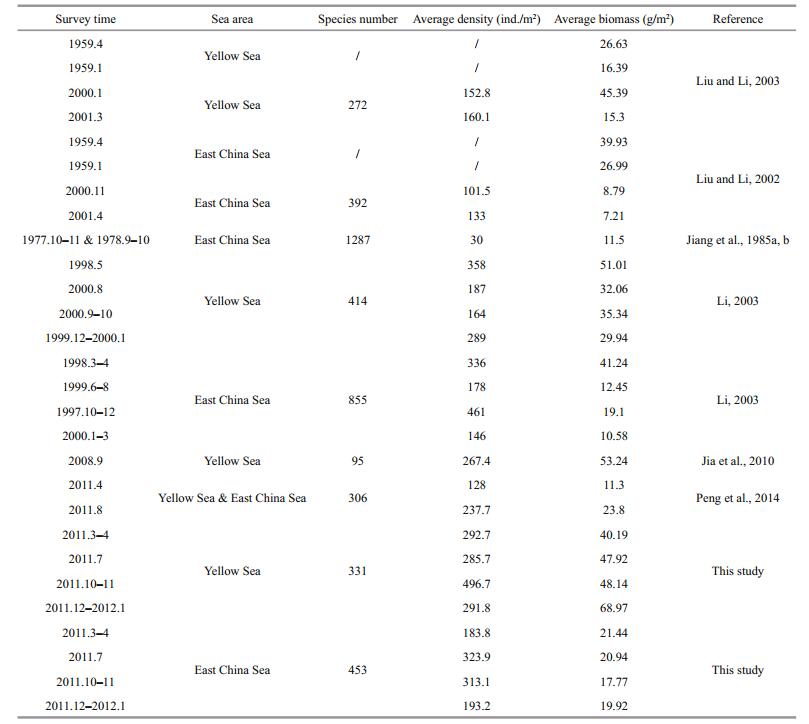
|
In terms of the spatial distribution of the macrobenthic communities, except for summer, the number of macrobenthos in the Yellow Sea was significantly larger than that in the East China Sea. This is related to the environments of the seas, including sediment type and water mass.
First, the sediment types in these two seas are different. Seafloor sediment in the Yellow Sea is siltbased, whose particles are coarser than those of the sand-based sediment in the East China Sea (Wang, 2013). The impact of sediment type on the macrobenthos distribution has two main two aspects. One is the availability of foods. That is, the pore size of sediment with fine particles is small, and nutrients in the sediment are not easily used by macrobenthos, leading to less food for macrobenthos than that in the sediment with coarse particles. In addition, there is various habitat heterogeneity in different types of sediments. The spatial heterogeneity of sediments with coarse particles is greater than that of sediments with fine particles. Strong spatial heterogeneity can not only provide diverse benthic habitats suitable for various types of benthic organisms in which to live, but also provide shelter from predators for such organisms. Therefore, species number, abundance and diversity of benthic organisms increase with the proportion of coarse gravels in sediments, according to Long and Lewis (1987). This distribution of benthic organisms has been confirmed in other studies. Benthic biodiversity in sandy mud and muddy sand was greater than those in sand or clay (Zhao and Wang, 2000). The various sediment types in the Yellow and East China Seas would affect the ecological types, nutritional characteristics, and community structure of benthic organisms (Liu et al., 1986). Sediment type would influence the abundance of benthic organisms, which is relatively low in sediment with fine particles (Jayaraj et al., 2008). At depths > 40 m, macrobenthos abundances in medium and coarse sand sediments were 25% higher than in other sediment types (Coleman et al., 2007).
Second, the relatively complex hydrologic environments of the two seas (Table 5) could determine the ecological groups of macrobenthos. The deep water of the Yellow Sea (depth > 40–50 m) is in its central part, where bottom water temperature is low and stable year-round. Dominant macrobenthos in this area are Thyasira tokunagai, Portlandia japonica, Ophiura sarsii vadicola, and Melinna cristata. The species composition of macrobenthic organisms there was almost constant between the 1950s and 1990s (Zhang, 2012). Because hydrologic conditions in continental-shelf waters of the East China Sea (open sea area distant from the 50–60 m isobath) is affected by the Kuroshio Current, bottom water temperature and salinity on the west side of this area are high year-round, and the dominant macrobenthos prefer high temperature and salinity. These include Dentalium octangulatum, Cavolinia sp., and Callianassa sp. In contrast, the shallow coastal waters of the East China and Yellow Seas (within the 40–50 m isobath) are mainly affected by the continental climate and river runoff, which induce clear seasonal changes of temperature and salinity. Therefore, dominant macrobenthos in this region are eurythermal and euryhaline species, such as Heromastus filiforms, Notomastus latericeus, Capitella capitata and Ampelisca sp. The complex hydrologic conditions in the two seas are undoubtedly important in determining the composition of benthic biota and differences in properties (Liu et al., 1986). CCA showed that temperature and water depth were the main environmental effects on the distribution of macrobenthos, revealing that with the action of different water masses, changes in bottom water temperature of the two seas influenced the composition and distribution of benthic organisms. Biomass and the secondary productivity of macrobenthos in the East China Sea were significantly affected by water temperature and depth (Li et al., 2005b, c). In addition, owing to the impact of the YSCM, biomass and secondary productivity of the macrobenthos were strongly affected by water temperature (Li et al., 2005c). Water depth, temperature and median particle size in the sediment were important influences on the distribution of macrobenthos in the southern Yellow Sea (Zhang, 2012). Similar patterns were found in plankton. For example, the species composition and distributions of planktonic bacteria, phytoplankton and zooplankton were all greatly shaped by water masses in the two seas (Li et al., 2006; Chen et al., 2011; Gao et al., 2013).
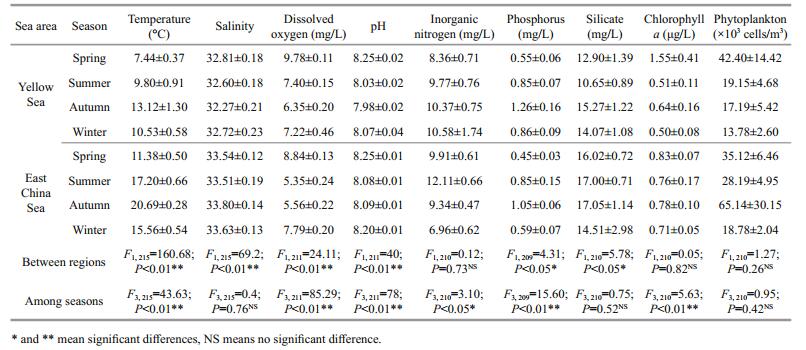
|
As the world's most important marginal seas, the East China and Yellow Seas have enormous pressures from rapid economic development. However, because of the high cost of marine ecological surveys, largescale spatiotemporal variations of macrobenthos communities have been unclear. Therefore, we conducted surveys during four cruises to show seasonal and spatial variations of macrobenthic communities in the Yellow and East China seas. In this study, we found the following: ⅰ) a total of 562 macrobenthic species were identified, with polychaetes and mollusks accounting for 67% of total species, with the dominant ones bivalve mollusks and small-sized polychaetes; ⅱ) based on the two-way ANOVA and two-factor community similarity analysis, there were significant spatiotemporal variations of macrobenthic community, such as seasonal variations in number of species, density and diversity index, and regional differences of biomass and density; ⅲ) based on relationships between macrobenthos and their living environments, sediment properties and water mass characteristics in the two seas were speculated to be the main causes of regional differences.
6 ACKNOWLEDGEMENTWe acknowledge HU Yuemei, WANG Bin, and JIN Haiyan for their assistance in the laboratory and field.
Anderson D M, Glibert P M, Burkholder J M. 2002. Harmful algal blooms and eutrophication: nutrient sources, composition, and consequences. Estuaries, 25(4): 704-726. DOI:10.1007/BF02804901 |
Chen H J, Qi Y P, Liu G X. 2011. Spatial and temporal variations of macro-and mesozooplankton community in the Huanghai Sea (Yellow Sea) and East China Sea in summer and winter. Acta Oceanologica Sinica, 30(2): 84-95. DOI:10.1007/s13131-011-0108-5 |
Clarke K R, Gorley R N. 2006. PRIMER v6: user manual/tutorial (Plymouth routines in multivariate ecological research). PRIMER-E, Plymouth.
|
Coleman N, Cuff W, Moverley J, Gason A S H, Heislers S. 2007. Depth, sediment type, biogeography and high species richness in shallow-water benthos. Marine and Freshwater Research, 58(3): 293-305. DOI:10.1071/MF06098 |
Conlan K, Aitken A, Hendrycks E, McClelland C, Melling H. 2008. Distribution patterns of Canadian Beaufort Shelf macrobenthos. Journal of Marine Systems, 74(3-4): 864-886. DOI:10.1016/j.jmarsys.2007.10.002 |
Crawford O T, Degraer S, Mallefet J, Zintzen V. 2007. Macrobenthos of shipwrecks within and around the Belgian waters as a potential food resource for fish populations. In: Zintzen V ed. Biodiversity of Shipwrecks from the Southern Bight of the North Sea. Vrije Universiteit Brussel, Brussel. p. 269-281.
|
Gao Y, Jiang Z B, Liu J J, Chen Q Z, Zeng J N, Huang W. 2013. Seasonal variations of net-phytoplankton community structure in the Southern Yellow Sea. Journal of Ocean University of China, 12(4): 557-567. DOI:10.1007/s11802-013-2258-x |
Hu H Y, Huang B, Tang J L, Ren S J, Shao X W. 2000. Studies on benthic ecology in coastal waters of Bohai and Yellow Seas. Donghai Marine Science, 18(4): 39-46. |
Hu H Y, Tang J L, Li Q L, Huang B, Chen Y H, Mao H Y, Zhang L. 2006. Studies on benthic ecology in Zhejiang coastal waters. Journal of Marine Sciences, 24(3): 76-89. |
Jayaraj K A, Sheeba P, Jacob J, Revichandran C, Arun P K, Praseeda K S, Nisha P A, Rasheed K A. 2008. Response of infaunal macrobenthos to the sediment granulometry in a tropical continental margine southwest coast of India. Estuarine, Coastal and Shelf Science, 77(4): 743-754. DOI:10.1016/j.ecss.2007.11.016 |
Jia H B, Hu H Y, Tang J L, Huang B, Mao H Y, Wang J Y, Wei N. 2010. The macrobenthos ecology of the southern Yellow Sea. Oceanologia et Limnologia Sinica, 41(6): 842-849. |
Jiang J X, Huang L Q, Meng F, Wu Q Q, Liu Q S, Lin S D, Yin X F, Xu H Z, Wang Z P, Dong Y T. 1985a. Species composition and distribution of benthic animals on the continental shelf of the East China Sea and it's adjacent waters. Taiwan Strait, 4(1): 89-98. |
Jiang J X, Wu Q Q, Huang L Q, Wang H Z, Meng F, Sun X Q. 1985b. A preliminary study on the quantity distribution of Macrobenthos in the East China Sea shelf and it's adjacent waters. Acta Oceanologica Sinica, 7(2): 246-255. |
Jiang Z B, Liu J J, Chen J F, Chen Q Z, Yan X J, Xuan J L, Zeng J N. 2014. Responses of summer phytoplankton community to drastic environmental changes in the Changjiang (Yangtze River) estuary during the past 50 years. Water Research, 54: 61-70. |
Kamp A, Witte U. 2005. Processing of 13C-labelled phytoplankton in a fine-grained sandy-shelf sediment (North Sea): relative importance of different macrofauna species. Marine Ecology Progress Series, 297: 297-61. DOI:10.3354/meps297297 |
Li B Q, Li X Z, Wang H F, Wang Y Q, Wang J B, Zhang B L. 2007a. Characters of a macrobenthic community offthe Changjiang River Estuary. Acta Zoologica Sinica, 53(1): 76-82. |
Li H B, Xiao T, Ding T, Lü R H. 2006. Effect of the Yellow Sea Cold Water Mass (YSCWM) on distribution of bacterioplankton. Acta Ecologica Sinica, 26(4): 1012-1020. DOI:10.1016/S1872-2032(06)60020-6 |
Li M T, Xu K Q, Watanabe M, Chen Z Y. 2007b. Long-term variations in dissolved silicate, nitrogen, and phosphorus flux from the Yangtze River into the East China Sea and impacts on estuarine ecosystem. Estuarine, Coastal and Shelf Science, 71(1-2): 3-12. DOI:10.1016/j.ecss.2006.08.013 |
Li R G. 2003. Macrobenthos on the Continental Shelves and Adjacent Waters, China Seas. Ocean Press, Beijing, China.
|
Li S Z, Cui B S, Xie T, Shao X J, Zhang M L. 2016b. Consequences and implications of anthropogenic desalination of salt marshes on macrobenthos. Clean-Soil Air Water, 44(1): 8-15. DOI:10.1002/clen.v44.1 |
Li S Z, Cui B S, Xie T, Zhang K J. 2016a. Diversity pattern of macrobenthos associated with different stages of wetland restoration in the yellow river delta. Wetlands, 36(S1): 57-67. DOI:10.1007/s13157-015-0641-7 |
Li X Z, Wang H F, Zhang B L. 2005a. The secondary production of macrobenthos in Jiaozhou bay, Shandong. Oceanologia et Limnologia Sinica, 36(6): 527-533. |
Li X Z, Wang J B, Wang H F, Zhang B L. 2005b. Secondary production of macrobenthos from the East China Sea. Chinese Journal of Applied & Environmental Biology, 11(4): 459-462. |
Li X Z, Yu H Y, Wang Y Q, Shuai L M, Zhang B L, Liu R Y. 2001. Study on species diversity of macrobenthic fauna in Jiaozhou Bay. Biodiversity Science, 9(1): 80-84. |
Li X Z, Yu Z S, Wang J B, Wang H F. 2005c. Study on the secondary production of macrobenthos from Southern Yellow Sea. Chinese Journal of Applied & Environmental Biology, 11(6): 702-705. |
Liao Y B, Shou L, Zeng J N, Gao A G. 2011. Spatiotemporal distribution of macrobenthic communities and its relationships with environmental factors in Sanmen Bay. Chinese Journal of Applied Ecology, 22(9): 2424-2430. |
Lin K X, Zhang Z N, Wang R Z. 2004. Research on biomass size spectra of macro-and meiofuana at typical stations in the East China Sea and Yellow Sea. Acta Ecologica Sinica, 24(2): 241-245. |
Liu L S, Li B Q, Lin K X, Cai W Q, Wang Q C. 2014. Assessing benthic ecological status in coastal area near Changjiang River estuary using AMBI and M-AMBI. Chinese Journal of Oceanology and Limnology, 32(2): 290-305. DOI:10.1007/s00343-014-3125-3 |
Liu L S, Li X Z. 2002. Distribution of macrobenthos in spring and autumn in the East China Sea. Biodiversity Science, 10(4): 351-358. |
Liu L S, Li X Z. 2003. Distribution of macrobenthos in spring and autumn in the southern Yellow Sea. Oceanologia et Limnologia Sinica, 34(1): 26-32. |
Liu L S, Meng W, Tian Z Q, Cai Y L. 2008. Distribution and variation of macrobenthos from the Changjiang Estuary and its adjacent waters. Acta Ecologica Sinica, 28(7): 3027-3034. |
Liu R Y, Cui Y H, Xu F S, Tang Z C. 1986. Ecological characteristics of macrobenthos of the Yellow Sea and the East China Sea. Studia Marina Sinica, 27: 27-153. |
Long B, Lewis J B. 1987. Distribution and community structure of the benthic fauna of the north shore of the Gulf of St. Lawrence described by numerical methods of classification and ordination. Marine Biology, 95(1): 93-101. |
Norkko A, Hewitt J E, Thrush S F, Funnell T. 2001. Benthicpelagic coupling and suspension-feeding bivalves: linking site-specific sediment flux and biodeposition to benthic community structure. Limnology and Oceanography, 46(8): 2067-2072. DOI:10.4319/lo.2001.46.8.2067 |
Peng S Y, Li X Z, Wang H F, Zhang B L. 2014. Macrobenthic community structure and species composition in the Yellow Sea and East China sea in jellyfish bloom. Chinese Journal of Oceanology and Limnology, 32(3): 576-594. DOI:10.1007/s00343-014-3068-8 |
Snelgrove P V R, Grassle J F, Grassle J P, Petrecca R F, Stocks K I. 2001. The role of colonization in establishing patterns of community composition and diversity in shallow-water sedimentary communities. Journal of Marine Research, 59(5): 813-831. DOI:10.1357/002224001762674953 |
Su J L, Yuan Y L. 2005. Hydrology in China Sea. Ocean Press, Beijing.
|
Ter Braak C J F, Šmilauer P. 2002. CANOCO Reference Manual and User's Guide to Canoco for Windows (version 4. 5). Centre for Biometry Wageningen, New York.
|
Wang H F, Li X Z, Wang J B. 2011. Macrobenthic composition and its changes in the Jiaozhou bay during 2000-2009. Oceanologia et Limnologia Sinica, 42(5): 738-752. |
Wang Y. 2013. Marine Geography of China. Science Press, Beijing, China.
|
Yi D H. 2002. Statistica 6. China Statistics Press, Beijing, China.
|
You Z J, Tao L, Jiao H F, Shi H X, Lou D. 2011. A survey of macrobenthos in the Xiangshan Bay. Oceanologia et Limnologia Sinica, 42(3): 431-435. |
Zhai W D, Chen J F, Jin H Y, Li H L, Liu J W, He X Q, Bai Y. 2014. Spring carbonate chemistry dynamics of surface waters in the northern East China Sea: Water mixing, biological uptake of CO2, and chemical buffering capacity. Journal of Geophysical Research: Oceans, 119(9): 5638-5653. DOI:10.1002/2014JC009856 |
Zhang J L. 2012. Biodiversity and comniunity structure of macrobenthos in the Yellow Sea. Graduate University of Chinese Academy of Sciences, Qingdao. p. 118. (in Chinese with English abstract)
|
Zhao H T, Wang L R. 2000. Classification of the coastal wetland in China. Marine Science Bulletin, 19(6): 72-82. |
| Anderson D M, Glibert P M, Burkholder J M, 2002. Harmful algal blooms and eutrophication: nutrient sources, composition, and consequences. Estuaries, 25(4): 704–726. Doi: 10.1007/BF02804901 |
| Chen H J, Qi Y P, Liu G X, 2011. Spatial and temporal variations of macro-and mesozooplankton community in the Huanghai Sea (Yellow Sea) and East China Sea in summer and winter. Acta Oceanologica Sinica, 30(2): 84–95. Doi: 10.1007/s13131-011-0108-5 |
| Clarke K R, Gorley R N. 2006. PRIMER v6: user manual/tutorial (Plymouth routines in multivariate ecological research). PRIMER-E, Plymouth. |
| Coleman N, Cuff W, Moverley J, Gason A S H, Heislers S, 2007. Depth, sediment type, biogeography and high species richness in shallow-water benthos. Marine and Freshwater Research, 58(3): 293–305. Doi: 10.1071/MF06098 |
| Conlan K, Aitken A, Hendrycks E, McClelland C, Melling H, 2008. Distribution patterns of Canadian Beaufort Shelf macrobenthos. Journal of Marine Systems, 74(3-4): 864–886. Doi: 10.1016/j.jmarsys.2007.10.002 |
| Crawford O T, Degraer S, Mallefet J, Zintzen V. 2007. Macrobenthos of shipwrecks within and around the Belgian waters as a potential food resource for fish populations. In: Zintzen V ed. Biodiversity of Shipwrecks from the Southern Bight of the North Sea. Vrije Universiteit Brussel, Brussel. p. 269-281. |
| Gao Y, Jiang Z B, Liu J J, Chen Q Z, Zeng J N, Huang W, 2013. Seasonal variations of net-phytoplankton community structure in the Southern Yellow Sea. Journal of Ocean University of China, 12(4): 557–567. Doi: 10.1007/s11802-013-2258-x |
| Hu H Y, Huang B, Tang J L, Ren S J, Shao X W, 2000. Studies on benthic ecology in coastal waters of Bohai and Yellow Seas. Donghai Marine Science, 18(4): 39–46. |
| Hu H Y, Tang J L, Li Q L, Huang B, Chen Y H, Mao H Y, Zhang L, 2006. Studies on benthic ecology in Zhejiang coastal waters. Journal of Marine Sciences, 24(3): 76–89. |
| Jayaraj K A, Sheeba P, Jacob J, Revichandran C, Arun P K, Praseeda K S, Nisha P A, Rasheed K A, 2008. Response of infaunal macrobenthos to the sediment granulometry in a tropical continental margine southwest coast of India. Estuarine, Coastal and Shelf Science, 77(4): 743–754. Doi: 10.1016/j.ecss.2007.11.016 |
| Jia H B, Hu H Y, Tang J L, Huang B, Mao H Y, Wang J Y, Wei N, 2010. The macrobenthos ecology of the southern Yellow Sea. Oceanologia et Limnologia Sinica, 41(6): 842–849. |
| Jiang J X, Huang L Q, Meng F, Wu Q Q, Liu Q S, Lin S D, Yin X F, Xu H Z, Wang Z P, Dong Y T, 1985a. Species composition and distribution of benthic animals on the continental shelf of the East China Sea and it's adjacent waters. Taiwan Strait, 4(1): 89–98. |
| Jiang J X, Wu Q Q, Huang L Q, Wang H Z, Meng F, Sun X Q, 1985b. A preliminary study on the quantity distribution of Macrobenthos in the East China Sea shelf and it's adjacent waters. Acta Oceanologica Sinica, 7(2): 246–255. |
| Jiang Z B, Liu J J, Chen J F, Chen Q Z, Yan X J, Xuan J L, Zeng J N, 2014. Responses of summer phytoplankton community to drastic environmental changes in the Changjiang (Yangtze River) estuary during the past 50 years. Water Research, 54: 61–70. |
| Kamp A, Witte U, 2005. Processing of 13C-labelled phytoplankton in a fine-grained sandy-shelf sediment (North Sea): relative importance of different macrofauna species. Marine Ecology Progress Series, 297: 297–61. Doi: 10.3354/meps297297 |
| Li B Q, Li X Z, Wang H F, Wang Y Q, Wang J B, Zhang B L, 2007a. Characters of a macrobenthic community offthe Changjiang River Estuary. Acta Zoologica Sinica, 53(1): 76–82. |
| Li H B, Xiao T, Ding T, Lü R H, 2006. Effect of the Yellow Sea Cold Water Mass (YSCWM) on distribution of bacterioplankton. Acta Ecologica Sinica, 26(4): 1012–1020. Doi: 10.1016/S1872-2032(06)60020-6 |
| Li M T, Xu K Q, Watanabe M, Chen Z Y, 2007b. Long-term variations in dissolved silicate, nitrogen, and phosphorus flux from the Yangtze River into the East China Sea and impacts on estuarine ecosystem. Estuarine, Coastal and Shelf Science, 71(1-2): 3–12. Doi: 10.1016/j.ecss.2006.08.013 |
| Li R G, 2003. Macrobenthos on the Continental Shelves and Adjacent Waters, China Seas. Ocean Press, Beijing, China. |
| Li S Z, Cui B S, Xie T, Shao X J, Zhang M L, 2016b. Consequences and implications of anthropogenic desalination of salt marshes on macrobenthos. Clean-Soil Air Water, 44(1): 8–15. Doi: 10.1002/clen.v44.1 |
| Li S Z, Cui B S, Xie T, Zhang K J, 2016a. Diversity pattern of macrobenthos associated with different stages of wetland restoration in the yellow river delta. Wetlands, 36(S1): 57–67. Doi: 10.1007/s13157-015-0641-7 |
| Li X Z, Wang H F, Zhang B L, 2005a. The secondary production of macrobenthos in Jiaozhou bay, Shandong. Oceanologia et Limnologia Sinica, 36(6): 527–533. |
| Li X Z, Wang J B, Wang H F, Zhang B L, 2005b. Secondary production of macrobenthos from the East China Sea. Chinese Journal of Applied & Environmental Biology, 11(4): 459–462. |
| Li X Z, Yu H Y, Wang Y Q, Shuai L M, Zhang B L, Liu R Y, 2001. Study on species diversity of macrobenthic fauna in Jiaozhou Bay. Biodiversity Science, 9(1): 80–84. |
| Li X Z, Yu Z S, Wang J B, Wang H F, 2005c. Study on the secondary production of macrobenthos from Southern Yellow Sea. Chinese Journal of Applied & Environmental Biology, 11(6): 702–705. |
| Liao Y B, Shou L, Zeng J N, Gao A G, 2011. Spatiotemporal distribution of macrobenthic communities and its relationships with environmental factors in Sanmen Bay. Chinese Journal of Applied Ecology, 22(9): 2424–2430. |
| Lin K X, Zhang Z N, Wang R Z, 2004. Research on biomass size spectra of macro-and meiofuana at typical stations in the East China Sea and Yellow Sea. Acta Ecologica Sinica, 24(2): 241–245. |
| Liu L S, Li B Q, Lin K X, Cai W Q, Wang Q C, 2014. Assessing benthic ecological status in coastal area near Changjiang River estuary using AMBI and M-AMBI. Chinese Journal of Oceanology and Limnology, 32(2): 290–305. Doi: 10.1007/s00343-014-3125-3 |
| Liu L S, Li X Z, 2002. Distribution of macrobenthos in spring and autumn in the East China Sea. Biodiversity Science, 10(4): 351–358. |
| Liu L S, Li X Z, 2003. Distribution of macrobenthos in spring and autumn in the southern Yellow Sea. Oceanologia et Limnologia Sinica, 34(1): 26–32. |
| Liu L S, Meng W, Tian Z Q, Cai Y L, 2008. Distribution and variation of macrobenthos from the Changjiang Estuary and its adjacent waters. Acta Ecologica Sinica, 28(7): 3027–3034. |
| Liu R Y, Cui Y H, Xu F S, Tang Z C, 1986. Ecological characteristics of macrobenthos of the Yellow Sea and the East China Sea. Studia Marina Sinica, 27: 27–153. |
| Long B, Lewis J B, 1987. Distribution and community structure of the benthic fauna of the north shore of the Gulf of St. Lawrence described by numerical methods of classification and ordination. Marine Biology, 95(1): 93–101. |
| Norkko A, Hewitt J E, Thrush S F, Funnell T, 2001. Benthicpelagic coupling and suspension-feeding bivalves: linking site-specific sediment flux and biodeposition to benthic community structure. Limnology and Oceanography, 46(8): 2067–2072. Doi: 10.4319/lo.2001.46.8.2067 |
| Peng S Y, Li X Z, Wang H F, Zhang B L, 2014. Macrobenthic community structure and species composition in the Yellow Sea and East China sea in jellyfish bloom. Chinese Journal of Oceanology and Limnology, 32(3): 576–594. Doi: 10.1007/s00343-014-3068-8 |
| Snelgrove P V R, Grassle J F, Grassle J P, Petrecca R F, Stocks K I, 2001. The role of colonization in establishing patterns of community composition and diversity in shallow-water sedimentary communities. Journal of Marine Research, 59(5): 813–831. Doi: 10.1357/002224001762674953 |
| Su J L, Yuan Y L, 2005. Hydrology in China Sea. Ocean Press, Beijing. |
| Ter Braak C J F, Šmilauer P. 2002. CANOCO Reference Manual and User's Guide to Canoco for Windows (version 4. 5). Centre for Biometry Wageningen, New York. |
| Wang H F, Li X Z, Wang J B, 2011. Macrobenthic composition and its changes in the Jiaozhou bay during 2000-2009. Oceanologia et Limnologia Sinica, 42(5): 738–752. |
| Wang Y, 2013. Marine Geography of China. Science Press, Beijing, China. |
| Yi D H, 2002. Statistica 6. China Statistics Press, Beijing, China. |
| You Z J, Tao L, Jiao H F, Shi H X, Lou D, 2011. A survey of macrobenthos in the Xiangshan Bay. Oceanologia et Limnologia Sinica, 42(3): 431–435. |
| Zhai W D, Chen J F, Jin H Y, Li H L, Liu J W, He X Q, Bai Y, 2014. Spring carbonate chemistry dynamics of surface waters in the northern East China Sea: Water mixing, biological uptake of CO2, and chemical buffering capacity. Journal of Geophysical Research: Oceans, 119(9): 5638–5653. Doi: 10.1002/2014JC009856 |
| Zhang J L. 2012. Biodiversity and comniunity structure of macrobenthos in the Yellow Sea. Graduate University of Chinese Academy of Sciences, Qingdao. p. 118. (in Chinese with English abstract) |
| Zhao H T, Wang L R, 2000. Classification of the coastal wetland in China. Marine Science Bulletin, 19(6): 72–82. |
 2018, Vol. 36
2018, Vol. 36



